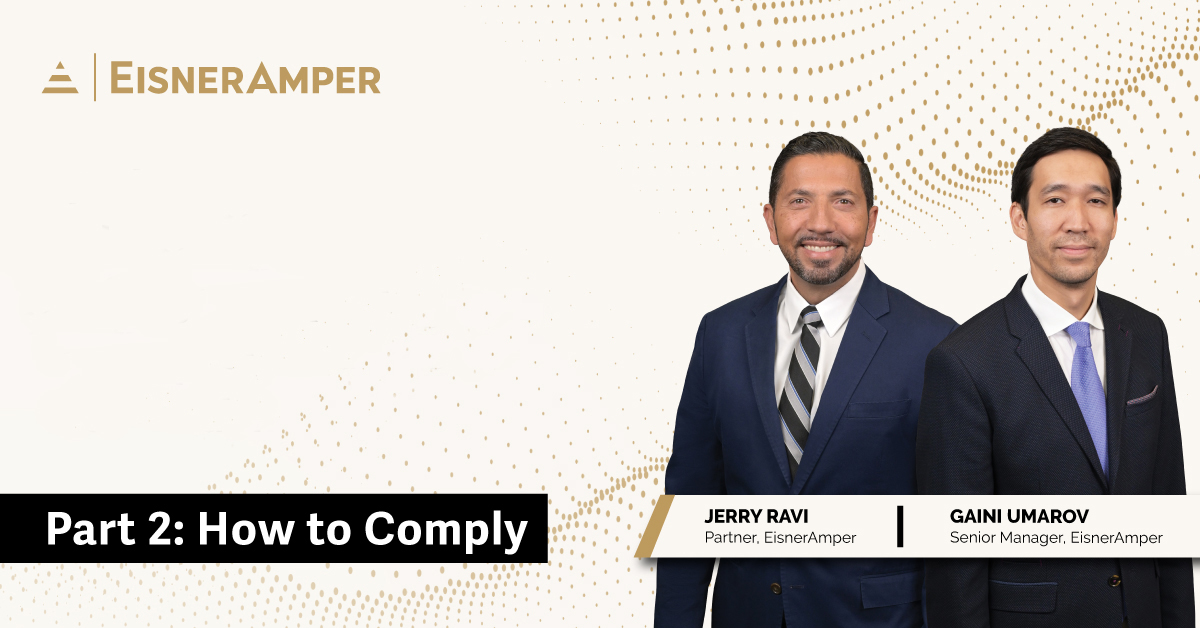
EisnerAmper Launches SEC Developments
- Published
- Aug 21, 2015
- Topics
- Share
SEC Developments is a new EisnerAmper blog designed to deliver content of interest to executives, and advisors to public companies, and others who act within an environment influenced by the United States Securities and Exchange Commission. On a quarterly basis we will aggregate these articles, along with new content, and release a newsletter of the same title.
Please do not hesitate to contact any of our editorial staff regarding any topics you would like to see covered or any comments you have.
Our editorial staff is composed of:
Michael Breit
Marc Fogarty
Michael McMurtry
Mark Sabates
Yan Zhang
SEC Adopts Rule Requiring CEO Pay Ratio Disclosure
Highlights of the New Rule
- The Securities and Exchange Commission adopted a final rule that requires most registrants to disclose the ratio of their principal executive officer’s total annual compensation to the total annual compensation of their median employee.
- Smaller reporting companies, foreign private issuers, emerging growth companies, registered investment companies and Canadian companies filing under the Multijurisdictional Disclosure System would not be subject to the requirement.
- The final rule provides flexibility in the methodology used to identify the median employee and calculate that employee’s total annual compensation, with related disclosure.
- The rule will be effective for the first fiscal year beginning on or after January 1, 2017.
Summary
On August 5, 2015, the SEC voted (3-2) to adopt a rule requiring public companies to disclose the ratio of the annual compensation of their chief executive officer to the median of the annual compensation of their employees. The new rule was mandated by the Section 953(b) of the Dodd-Frank Wall Street Reform and Consumer Protection Act.
Key Provisions
Methodology for Identifying the Median Employee
To identify the median employee, companies are allowed to select a methodology based on their own facts and circumstances and use either the total population of employees or a statistical sample of that population.
Companies will be required to include all employees – U.S. and non-U.S., full-time, part-time, temporary and seasonal – employed by the company or any of its consolidated subsidiaries as of a date selected by the company within the last 3 months of its fiscal year. The rule permits companies to exclude (i) certain non-U.S. employees from this determination in instances where foreign data privacy laws prevent companies from obtaining such information and a legal opinion supports such assertion (the “data privacy exemption”) and (ii) up to 5% of non-U.S. employees (inclusive of those employees excluded by the data privacy exemption), provided that if the companies exclude any non-U.S. employee in a particular jurisdiction, it must exclude all non-U.S. employees in that jurisdiction.
Companies may, but will not be required to, annualize total compensation for a permanent employee who did not work for the entire year, such as a new hire. However, companies are not permitted to make full-time equivalent adjustments for part-time employees or to include annualized adjustments for temporary and seasonal workers.
Determination of Total Compensation
Companies will be required to calculate the annual total compensation for its median employee for the last completed fiscal year in accordance with existing SEC executive compensation disclosure rules under Item 402(c)(2)(x) of Regulation S-K. The rule permits companies to use reasonable estimates when calculating annual total compensation.
Disclosure
Companies must disclose:
- the median employee’s annual total compensation;
- the CEO’s annual total compensation;
- the ratio of these two amounts (expressed as a ratio (e.g., the pay ratio is x:1), or as a multiple (e.g., the CEO annual compensation is x times the median employee’s annual compensation));
- a description of the methodology used to identify the median employee; and
- any material assumptions, adjustments (including cost-of-living adjustments), or estimates used to identify the median employee or to determine annual total compensation.
Companies will be permitted, but not required, to supplement the required disclosure with a narrative discussion or additional ratios.
The rule also permits companies to use the same median employee for the 3 most recent fiscal years unless there has been a change in the employee population or compensation arrangements that would significantly impact the calculation.
Compliance Dates
The CEO pay ratio disclosure is required in registration statements, proxy and information statements and annual reports that must already include executive compensation information as set forth under Item 402 of Regulation S-K.
Companies will be required to report pay ratio disclosure for their first fiscal year beginning on or after January 1, 2017. Therefore, a calendar-year company will be required to report pay ratio disclosure in 2017 for the first time in the proxy statement for its 2018 annual meeting.
Considerations
Companies should start to gather the necessary data to determine the most efficient way to calculate the pay ratio. Companies with foreign operations should consider if there are data privacy laws that could prevent obtaining the necessary information and will require a legal opinion.
Contact EisnerAmper
If you have any questions, we'd like to hear from you.
Receive the latest business insights, analysis, and perspectives from EisnerAmper professionals.











